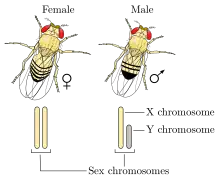Heterogametic sex
The heterogametic sex (or digametic sex) is the sex of a species where an individual's gametes have non-matching sex chromosomes. In humans, the heterogametic sex is the male sex, where each gamete's sex chromosomes are X and Y. This is in contrast to the female sex, where each gamete's sex chromosomes are X and X. This arrangement is understood within the XY sex-determination system.[1]


Non-human animals often have different sex arrangements than humans. In birds, the male sex is the homogametic sex, having two Z chromosomes, while the female sex is the heterogametic sex, with one Z and one W chromosome. In platypuses, the male sex is heterogametic while the female sex is the homogametic sex. Among the insects, Lepidopterans (butterflies and moths) have heterogametic females, but in Drosophila, males are the heterogametic sex. This arrangement is known as the ZW sex-determination system.[2]
Heterogametic sex determination systems typically have an approximately equal sex ratio, with distributions of sexes conforming to binomial variance.[3] However, in practice, some populations deviate from this expectation, in a phenomenon termed sex ratio distortion. Sex ratio distortion has been observed in mice,[4] mosquitos,[5] and other organisms[6] and can be caused by meiotic drive elements.
Heterogamesis can lead to reduced or absent meiotic recombination between the sex chromosomes, and in some species, this extends to the autosomes, a phenomenon called achiasmy. For example, most lineages of male Drosophila melanogaster flies are achiasmic, lacking recombination on all chromosomes, although females show recombination.[7]
See also
- Haldane's rule, concerns hybrid speciation
- Haldane-Huxley rule, concerns achiasmy
References
- King R.C.; Stansfield W.D.; Mulligan P.K. (2006). A Dictionary of Genetics (7th ed.). Oxford. p. 204.
- James Franklin Crow; William F. Dove, eds. (2000). Perspectives on genetics: anecdotal, historical, and critical commentaries, 1987–1998. Madison, WI: University of Wisconsin Press. ISBN 978-0-299-16604-5.
- Hardy, Ian C. W.; Boulton, Rebecca A. (1 January 2019). "Sex Allocation, Sex Ratios and Reproduction☆". Encyclopedia of Animal Behavior (Second Edition): 464–471. doi:10.1016/B978-0-12-809633-8.90122-5. ISBN 9780128132524.
- Haines, Brett A; Barradale, Francesca; Dumont, Beth L (20 August 2021). "Patterns and mechanisms of sex ratio distortion in the Collaborative Cross mouse mapping population". Genetics. 219 (3). doi:10.1093/genetics/iyab136. PMC 8570777. PMID 34740238.
- Wood, Roger J.; Newton, Martha E. (1 March 1991). "Sex-Ratio Distortion Caused by Meiotic Drive in Mosquitoes". The American Naturalist. 137 (3): 379–391. doi:10.1086/285171. ISSN 0003-0147. S2CID 84366854.
- Compton, Austin; Tu, Zhijian (2022). "Natural and Engineered Sex Ratio Distortion in Insects". Frontiers in Ecology and Evolution. 10. doi:10.3389/fevo.2022.884159. ISSN 2296-701X. PMC 9635402. PMID 36339946.
- Lenormand, Thomas (February 2003). "The Evolution of Sex Dimorphism in Recombination". Genetics. 163 (2): 811–22. doi:10.1093/genetics/163.2.811. PMC 1462442. PMID 12618416.